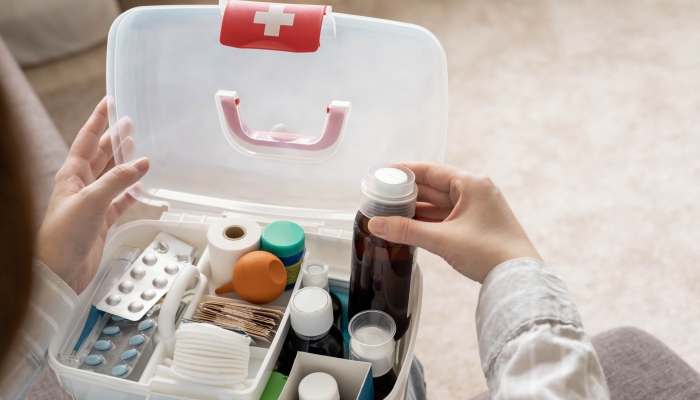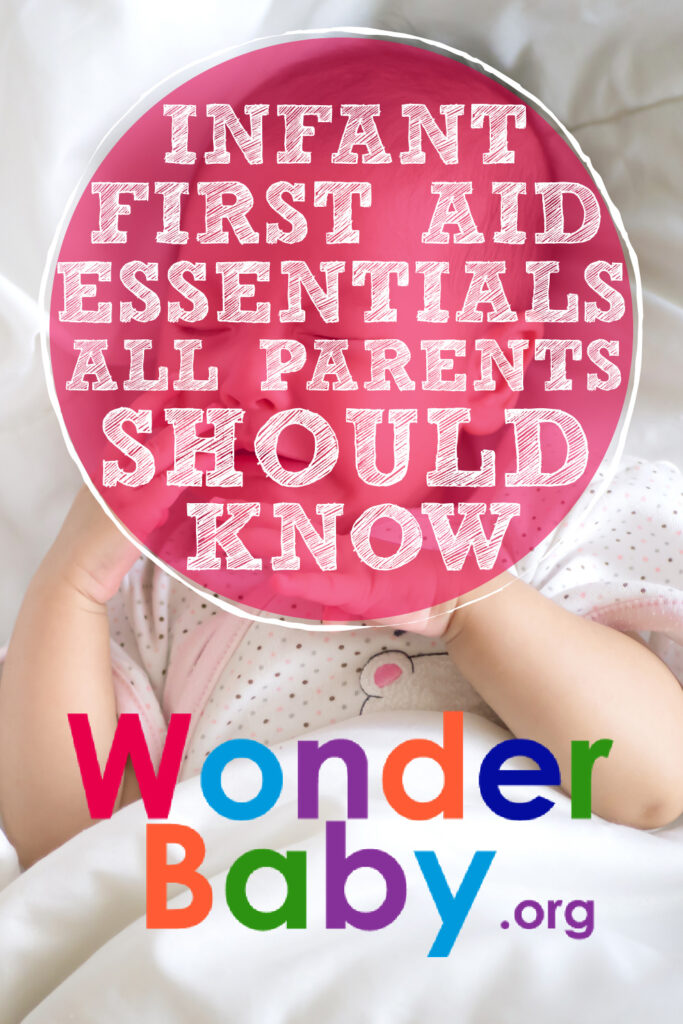3 Infant First Aid Essentials All Parents Should Know

- Babies are more likely to experience choking episodes than older children.
- Febrile seizures, while scary, can generally be safely managed at home.
- Some burn and scald injuries can be managed at home, while others require emergency medical treatment.
“Kids should come with an owner’s manual.”
I remember laughing about this with a close friend when our children were babies. We were in the throes of deciphering different cries, learning how to childproof, and wondering how to manage those first bumps, boo-boos, and owies. There’s so much to learn with a new baby!
Wouldn’t it be lovely if you could receive a manual when your child is born and automatically know how to respond to a given situation—particularly when your child is injured?
Childhood is a time of learning for parents and their children alike. While you may be well-versed in diapering and soothing skills, chances are you’ll need to develop essential first-aid skills to respond to unexpected medical situations involving your little one.
As it happens, you may not need that owner’s manual after all for your infant—you just need to know how to get started and when to call for help.
1. Choking Hazards and Response

When babies begin solid foods11. When, what, and how to introduce Solid Foods. Centers for Disease Control and Prevention. 2023. https://www.cdc.gov/nutrition/infantandtoddlernutrition/foods-and-drinks/when-to-introduce-solid-foods.html at approximately four months of life, the risk of choking increases.
This is partly because infants need to learn how to coordinate breathing, chewing, and swallowing. Sometimes, this leads to unintentional choking.
At other times, choking happens for different reasons.
Common Choking Hazards
Have you ever noticed that babies and young children tend to put everything in their mouths?
This behavior is known as mouthing, which babies use to learn about different objects’ physical properties and develop spatial perception.
According to a 2007 study22. Fagan, M. K., & Iverson, J. M.. The Influence of Mouthing on Infant Vocalization. Infancy. 2010;11(2), 191–202. https://doi.org/10.1111/j.1532-7078.2007.tb00222.x, it’s also thought to influence speech and language development.
The American Academy of Pediatrics (AAP) describes the following objects as potential choking hazards33. Choking Prevention. HealthyChildren.org. 2019. https://www.healthychildren.org/English/health-issues/injuries-emergencies/Pages/Choking-Prevention.aspx for infants and young children:
- Coins
- Buttons
- Toys with small parts
- Toys that can fit fully in a child’s mouth
- Small balls or marbles
- Balloons or balloon fragments
- Small hair bows, barrettes, or rubber bands
- Pen or marker caps
- Small button-type batteries
- Refrigerator magnets
- Pieces of dog food
Childproofing your home as soon as your baby becomes mobile is an important step to protect your child and reduce the risk of your child ingesting non-edible objects.
Recognizing Signs of Choking
A young child’s airway is approximately the diameter of a drinking straw or your pinky finger.
When you understand exactly how small that breathing passage is, combined with the lack of teeth to grind food, a large tongue and other structural airway differences44. Paediatric Airway Anatomy. PIVARES. https://www.pivares.com/paediatricairwayanatomy, and the boundless curiosity of a young child, it’s no wonder that babies and young children are at an increased risk of choking.
The American Red Cross55. Infant Choking: How To Help. Red Cross. https://www.redcross.org/take-a-class/resources/learn-first-aid/infant-choking reports that signs of choking in an infant or young child may look like:
- A weak, ineffective cough or no cough.
- High-pitched squeaking or whistling noises (no sound is also possible).
- Pale or blue skin color.
- Being unable to cough or cry.
- A panicked, confused, or surprised appearance.
Any of the above signs are considered a medical emergency and require immediate care from qualified healthcare providers.
Responding to Choking Infants
Check out the following video clip from an American Red Cross training instructor to learn step-by-step instructions to help an alert, choking infant:
Be prepared to summon emergency medical personnel if your efforts don’t seem to help your child who is choking or if they lose consciousness.
2. Handling Febrile Seizures

Febrile seizures (fevers that occur because of a sudden, high fever typically over 101℉) tend to occur in infants and young children.
These types of seizures are usually associated with a viral illness and are not necessarily considered to be predictive of a child being diagnosed with epilepsy later in life.
However, a 2016 study66. Lee, S. H., Byeon, J. H., Kim, G. H., Eun, B.-L., & Eun, S.-H.. Epilepsy in children with a history of febrile seizures. Korean Journal of Pediatrics. 2016;59(2), 74. https://doi.org/10.3345/kjp.2016.59.2.74 found that febrile seizures occurring with factors such as preterm birth, developmental delay, and documented electroencephalogram (EEG) changes tend to lead to the development of epilepsy.
Management of Febrile Seizures
It can be scary and disorienting to watch your child endure a febrile seizure. How can we as parents best care for our children during this experience?
Experts from the Epilepsy Foundation77. Primiani, C. T.. Febrile Seizures. Epilepsy Foundation. https://www.epilepsy.com/what-is-epilepsy/seizure-types/febrile-seizures recommend staying with your child, positioning them on their side, and ensuring that their immediate surroundings are clear of objects that your child could potentially hit or bang into. Avoid holding your child down or placing anything in their mouth, as the person experiencing a seizure may choke.
Febrile seizures can generally be managed at home. However, the Epilepsy Foundation of Minnesota88. Seizure First Aid. Epilepsy Foundation of Minnesota. https://www.epilepsyfoundationmn.org/about-epilepsy/seizure-first-aid/ recommends that parents seek prompt medical attention or call 911 for their child if:
- You know (or suspect) that this is your child’s first seizure.
- The seizure lasts longer than five minutes.
- More than one seizure occurs in rapid succession (seizure clusters).
- Your child is injured.
- The seizure occurs in water (such as a bathtub).
- You feel uncomfortable dealing with the situation.
Note: According to the Epilepsy Foundation, while giving your child fever-reducing medications, sponging with cool cloths, or running a tepid bath may make your feverish child feel better, these measures aren’t able to prevent febrile seizures.
3. Managing Burns and Scalds

Burns and scald injuries can be a serious problem for children and their parents.
Burns are of particular concern for infants and young children because their skin is thinner, meaning they can experience a greater degree of burn injury more quickly than adults.
How Bad is the Burn?
Did you know that burns are rated according to severity?
The higher the number, the greater the degree of injury and damage to the layers of skin and underlying structures.
Check out the burn rating system as described by Stanford Medicine99. Burn Stages. Stanford Health Care. https://stanfordhealthcare.org/medical-conditions/skin-hair-and-nails/burns/stages.html and what symptoms are seen with each level here:
| Burn type: | Skin layers involved: | Burn site looks like: |
| First-degree (superficial) | Epidermis (outer layer of skin) only | Red, painful, dry, and has no blisters |
| Second-degree (partial thickness) | Epidermis and part of the dermis (deeper layer) of skin | Red, blistered, much more painful, and may be swollen |
| Third-degree (full thickness) | Destroys the epidermis and dermis; damage to underlying bones, muscles, and tendons is also possible | White, blackened, or charred; no sensation because the nerve endings have been destroyed |
Promptly notify your child’s healthcare provider or seek emergency treatment if your child has a burn or scald injury.
Burn Care
Experts from the American Burn Association1010. Initial First Aid Treatment for Minor Burns. American Burn Association. https://ameriburn.org/wp-content/uploads/2017/05/burnfirstaid.pdf recommend the following strategies to manage burns:
- First-degree burns: Immediately soak the burn in cool water for 5–10 minutes or use cold, wet compresses. Once the pain has diminished, apply a thin layer of petroleum jelly to the burned area two to three times a day and cover it with a nonstick, sterile bandage. Do not disrupt any blisters that may form as the skin heals.
- Second-degree burns: Generally speaking, if a partial thickness burn is “smaller than 2–3 inches (7 centimeters), it may be treated as a minor burn.” If the burned area is larger than 2–3 inches or involves areas of the body like the head, face, feet, eyes, ears, diaper area, or over major joints, seek emergency medical care.
- Third-degree burns: These are very serious burns and should not be managed at home. Seek emergency care immediately.
Correct burn care is important to stop the burning process, prevent infection, and decrease scar formation.
Providing first aid for an infant can initially seem scary and overwhelming. However, learning a few basic medical skills and knowing when to call for help can go a long way in helping you feel prepared to respond to your child’s injuries.
References
- When, what, and how to introduce Solid Foods. Centers for Disease Control and Prevention. (2023, June 27). https://www.cdc.gov/nutrition/infantandtoddlernutrition/foods-and-drinks/when-to-introduce-solid-foods.html
- Fagan, M. K., & Iverson, J. M. (2010). The Influence of Mouthing on Infant Vocalization. Infancy, 11(2), 191–202. https://doi.org/10.1111/j.1532-7078.2007.tb00222.x
- Choking Prevention. HealthyChildren.org. (2019, September 30). https://www.healthychildren.org/English/health-issues/injuries-emergencies/Pages/Choking-Prevention.aspx
- Paediatric Airway Anatomy. PIVARES. (n.d.). https://www.pivares.com/paediatricairwayanatomy
- Infant Choking: How To Help. Red Cross. (n.d.). https://www.redcross.org/take-a-class/resources/learn-first-aid/infant-choking
- Lee, S. H., Byeon, J. H., Kim, G. H., Eun, B.-L., & Eun, S.-H. (2016). Epilepsy in children with a history of febrile seizures. Korean Journal of Pediatrics, 59(2), 74. https://doi.org/10.3345/kjp.2016.59.2.74
- Primiani, C. T. (n.d.). Febrile Seizures. Epilepsy Foundation. https://www.epilepsy.com/what-is-epilepsy/seizure-types/febrile-seizures
- Seizure First Aid. Epilepsy Foundation of Minnesota. (n.d.). https://www.epilepsyfoundationmn.org/about-epilepsy/seizure-first-aid
- Burn Stages. Stanford Health Care. (n.d.). https://stanfordhealthcare.org/medical-conditions/skin-hair-and-nails/burns/stages.html
- Initial First Aid Treatment for Minor Burns. American Burn Association. (n.d.). https://ameriburn.org/wp-content/uploads/2017/05/burnfirstaid.pdf

The information WonderBaby provides is not intended to be, and does not constitute, medical or other health advice or diagnosis and should not be used as such. Always consult with a qualified medical professional about your specific circumstances.
Related Posts

Eye Conditions and Syndromes, Visual Impairment
Neuralink Announces Plans to Restore Sight to the Blind with Brain Chip
Elon Musk’s company Neuralink has announced plans to begin human trials of its new “Blindsight” brain chip by the end of 2025.

Health & Nutrition
Can Baby Skin Care Products Expire?
Is that forgotten tube of diaper rash cream still safe to use? Learn more about the expiration dates of popular skin care products for infants.

Health & Nutrition
Boosting Immunity in Kids: 3 Tips for a Healthy Winter
Parents can help boost their kids’ immunity during cold and flu season by maintaining healthy eating, sleeping, and exercising habits in the winter.